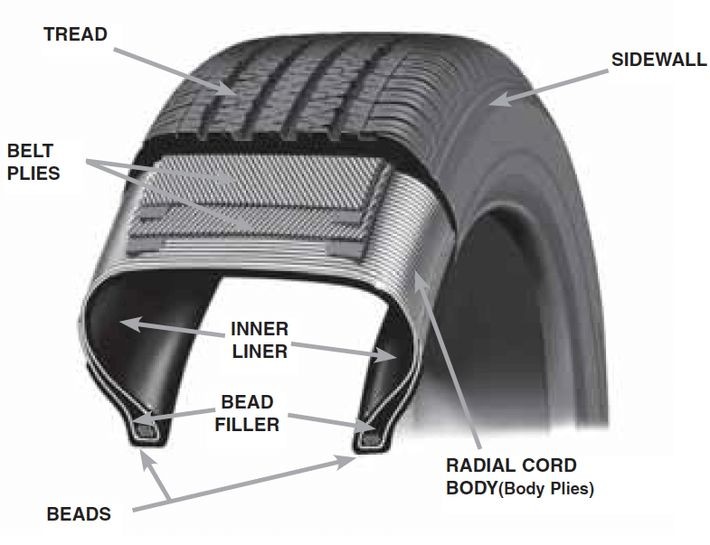Shopping for tires can be overwhelming, especially when faced with technical terms and unfamiliar features. Understanding the different Parts On A Car Tire is crucial for making informed decisions, ensuring safety, and optimizing your vehicle’s performance. Whether you’re concerned about “optimized variable pitch tread blocks” or “directional tread patterns,” knowing the basics empowers you to choose the best tires for your needs. This guide breaks down the essential components of a car tire, regardless of whether it’s for a passenger car, SUV, CUV, or light truck.
Tire Parts Diagram
 parts of a tire diagram
parts of a tire diagram
Diagram illustrating the anatomy of a car tire, showcasing various parts such as tread, sidewall, belt plies, inner liner, radial cord body, bead filler, and beads.
Beads
Starting from the innermost part that interacts with your wheel, the beads are essential parts on a car tire responsible for securing the tire to the wheel rim. Think of them as the anchor points. Constructed from high tensile steel wires, plated with copper, brass, or bronze, and formed into a robust rubber band, the beads prevent the tire from slipping or detaching from the rim as the wheel rotates and bears load.
Bead Filler
Adjacent to the beads is the bead filler, a rubber compound that plays a critical role in the stability of the lower sidewall and the bead area itself. This component is a key part on a car tire influencing handling and responsiveness. The density and stiffness of the bead filler are carefully engineered to contribute to the tire’s overall performance characteristics, affecting everything from steering precision to ride comfort.
Radial Cord Body
The radial cord body is a fundamental structural part on a car tire, providing the tire with its strength and enabling the transmission of cornering forces between the tread and the wheel. This body is composed of rubber-coated fabric cords, known as body plies, which can be made from materials like polyester, rayon, or nylon, with polyester being the most common choice due to its balance of strength and flexibility.
Inner Liner
Acting as a modern-day inner tube, the inner liner is a layer of rubber compound bonded to the inside of the cord body. This crucial part on a car tire is responsible for maintaining air pressure within the tire. Unlike older tire designs that used separate inner tubes, modern tires utilize this inner liner to create an airtight chamber directly within the tire structure, working in conjunction with the beads and bead filler to contain air.
Belt Plies
Positioned just beneath the tread, the belt plies are robust layers of cord that enhance the strength and stability of the tire’s tread area. These parts on a car tire are vital for improving tire durability, resistance to impacts, and overall traction. Steel is the most frequently used material for belt plies due to its high tensile strength and ability to provide rigid support to the tread.
Sidewall
The sidewall is the side area of the tire, extending from the bead up to the edge of the tread. This part on a car tire not only provides a protective covering for the cord body but also serves as the information hub of the tire. Crucial details such as tire size, load index, and speed rating are imprinted on the sidewall. Moreover, the rubber compounds used in sidewalls are formulated to withstand environmental factors like ozone, as well as physical damage from cuts and snags.
Tread
The tread is the outermost part on a car tire designed for direct contact with the road surface. It’s arguably the most critical component in terms of performance and safety. The tread’s rubber compound and pattern are meticulously engineered to strike a balance between various factors, including wear resistance, traction (in both wet and dry conditions), handling responsiveness, fuel efficiency, and noise reduction. Tread designs vary significantly depending on the intended use of the tire.
For instance, all-season tires like the Destination LE2 feature circumferential tread grooves, designed to efficiently channel water away from the contact patch to enhance wet traction and reduce hydroplaning risk. Conversely, high-performance all-season tires like the Firehawk GT Pursuit, designed for law enforcement and emergency vehicles, utilize an asymmetrical tread pattern. This design incorporates larger tread blocks on the outer shoulder to maximize dry grip and handling, while the inner shoulder features smaller, more numerous elements to improve traction in wet and snowy conditions.
Ensuring a safe and confident driving experience begins with understanding your tires. By familiarizing yourself with the parts on a car tire, you can better appreciate how each component contributes to overall performance and safety. For expert guidance on selecting the right tires for your vehicle and learning more about tire maintenance, consult with professionals at your local Firestone Complete Auto Care.